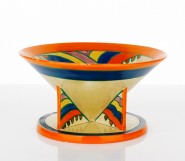Lot #13 - Pablo Picasso
-
Auction House:Mossgreen
-
Sale Name:Fine Australian & International Art
-
Sale Date:02 May 2016 ~ 6.30pm - Part 1 - Lots 1 - 47
03 May 2016 ~ 2.30pm - Part 2 - Lots 48 - 320 -
Lot #:13
-
Lot Description:Pablo Picasso
(Spanish, 1881-1973)
Minotaure Caressant une Dormeuse 1933
drypoint etching, from the Vollard edition of 310
29.5 x 36 cm
signed lower right: Picasso; watermarked to left margin: Vollard -
Provenance:Galerie Michael, Beverly Hills; Private collection, Melbourne
-
References:George Bloch, Pablo Picasso: Catalogue de l'oeuvre gravé et lithographié, Editions Kornfeld, Bern, 1968, 71, no. 201 (another example); Brigette Baer and Bernhard Geiser, Picasso, peintre-graveur, 2 volumes, éditions Kornfeld, 1990 (vol. 1) and 1992 (vol. 2), no. 369.
-
Notes:The Vollard Suite of etchings, aquatints and drypoints, created between 1930 and 1937 - a key period in the development of Pablo Picasso's art - can be placed, without exaggeration, among the most significant and resolved bodies of graphic works in the history of Western art.Through content, form and allegory, Picasso at once nods to his artistic progenitors whilst asserting himself as a Modernist. The ensemble of black and white images is an essay in the continuity of the medium's tradition. It pays homage to the print-making heritage of Rembrandt, (to the point of directly representing the Dutchman himself in a number of plates), as well as acknowledging his compatriota, Goya, whose influential Taurmaquias are echoed in the climatic funereal sequence of the bullfighting scenes which close the Suite. The group of images confirms that Picasso, more than any of his contemporaries, was a product of his time, looking to reinvent and redevelop his visual vocabulary. The lucidity in his crisp and crinkled lines is the work of a mature artist and his distinctive qualities cannot be imagined without the cubist distortions he himself introduced two decades earlier. However, as Robert Hughes has noted, it was not just formal mastery that distinguished his singular work. In the eyes of the late critic, Picasso's place in twentieth century consciousness was aided by his 'unrivalled capacity for generating metaphors and images of metamorphoses.'1 Nowhere are these two features of the essential Picasso, employed more emphatically than in the Vollard Suite. The collection of one hundred images was commissioned by, and later named after, Ambroise Vollard - the Parisian art dealer who, back in 1901, had given el espa–ol his first exhibition in France. The majority of the intaglios were executed in the early 1930s following Picasso's purchase of a new ch‰teau-studio in Boisgelup, a small village sixty-three kilometres outside of Paris. In the tranquillity of this hamlet, Picasso would spend long days with his young muse, lover, and later mother of his first child, Marie-Thérèse Walter. And it is they, Marie and Pablo, who are the protagonists of the passions and struggles in the Vollard Suite. Their identities, however, are woven in the oeuvre's two major themes stemming from Picasso's interest in Classical literature: the Minotaur (the half-man half-bull creature) and Pygmalion (the artist who fell in love with his model), both characters taken from Ovid's Metamorphoses. In developing the series, Picasso introduced the Minotaur in May 1933 as a replacement for Pygmalion the sculptor - the artist's original alter-ego. This new personage, the mythical man-beast, served as a fitting symbol of the artist's own legendary artistic vitality and sexual energy. Marie-Thérèse continues to feature throughout the suite as an object of Picasso's desires: though she goes from being a sensual ivory goddess, adored by the sculptor who brought her into existence and morphs into the sexually charged lover of the hairy, yet dignified, man-bull. In Minotaure Caressant une Dormeuse, the beautiful, nude Marie is at her most vulnerable. In deep, satisfying sleep, she is hardly perturbed by the dominant presence of the towering Minotaur who is, by contrast, fixed on her; this indifference only accentuates the hybrid beast's gentleness and tender caress of the woman's hand. Going beyond the imagery, Picasso the peintre-graveur, demonstrates his technical proficiency in the handling of the intaglio. Departing from the clean and graceful lines that distinguished the images of Pygmalion and his muse, the present work, is made up of various techniques of mark-making: from the nervous, yet crisp outline of the male and female figures, to the curly and wiry squiggles of hair covering the Minotaur's head and chest; from the light and soft linear shading between the two lovers, to the compact crosshatched blanket in the darkened background. In moving effortlessly between various styles and techniques - a Picassoan trait par excellence - we are reminded of the genius of the Spanish master. Although Picasso continued to produce graphic prints till the very end of his career, he would never quite recapture the intensity or creative genius that characterises this impassioned series. A key image in Picasso's oeuvre, Minotaure Caressant une Dormeuse remains one of the most prized and collected of all graphic works by that quasi-mythical figure in twentieth century art. Petrit Abazi 1 Robert Hughes, 'Picasso', in The Fifth Sir William Dobell Memorial Lecture, The Sir William Dobell Art Foundation, Sydney, 1981, p.5.
-
Estimate:A$40,000 - 60,000
-
Realised Price:
-
Category:Art
This Sale has been held and this item is no longer available. Details are provided for information purposes only.










